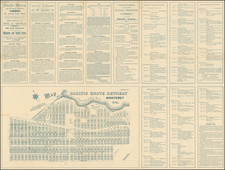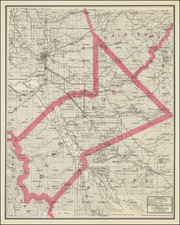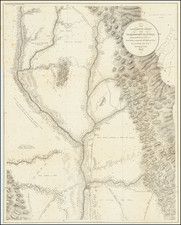Detailed survey of most of Yountville, in Napa County, drawn by T. J. Dewoody, County Surveyor of Napa County, identifying the lands owned by James M. (Matt) Harbin in Yount Township.
The surveyed portion of the lands shown on this map begin at approximately the modern interesection of Madision Street and the County Road (St. Helena Highway), focused on the lands west of the Highway and south to the Yountville Veterans Home of California is located. A portion of the land on the map includes the lands sold by Harbin, Boggs and Hooper to Gottlieb Groezinger, which would become one of Napa Valley's first major wine producers.
The county road is shown as the northeastern boundary, extending to the hills to the west of the current Yountville Vetnerans Home.
An early survey of the region, conducted by T. J. Dewoody, who would serve as Napa County Surveyor for at least a decade in the 1850s and 1860s. The note from Dewoody states:
I, T. J. Dewoody, County Surveyor of Napa County, State of California, hereby certify, That the lines shaded yellow on this plat and embracing the tracts marked H.C. Boss and H.C. B. - show all the lands owned by J.M. Harbin in Yount Tonwship Napa County on the 4th day of September 1857 as shown by the records of said County . . .
At the northern tip of the Surveyed land, the name Sebastapol is shown, on the lands then owned by James M. Harbin. This would appear to be the " two-block addition surveyed [in 1855] in the northeast corner of [Harbin's] property south of Madison and fronting the county road . . . " referenced in “Yountville: The Beginnings” by John Holt.
Names shown on the map include:
- John Grigsby -- Captain John Gribsby (1806-1925) led the Grigsby-Ide party from Missouri to California in 1845. Grigsby settled in Napa Valley, on land obtained from George Yount and later from Salvadore Vallejo. He became a member of the Bear Flag Party which declared its (brief) independence from Mexico.
- James M. Harbin came overland to California in 1846. He claimed a portion of Salvador Vallejo's Napa Grant in 1853 and as noted above had laid out a 2 block subdivision in the future Yountville in 1855.
- W.S. Clark acquired his land from J.M. Harbin by deed dated June 25, 1856
- S.M. Whitton - this is likely the lands owned by Greene and Sarah Whitton or family, among the earliest Napa Valley settlers.
- H.C. Boggs -- Likely Henry C. Boggs, son of Lilburn William Boggs, the 6th Govenor of Missouri (1836-1840), who moved to California in 1846 and initially settled in Sonoma. He was elected to the California State Assembly in 18 and retired to Rancho Napa in 1855.
The map was likely used as an Exhibit in a Land Grant related court case, most likely the case which confirmed to James M. Harbin that included the Sebastabol addition noted on this map.
Yountville
During the early part of the 1800’s, the area that now makes up the Town of Yountville was a part of Spain and later Mexican Alta California.
George C. Yount received an 11,887-acre land grant from the Mexican government in 1836 which included the future town. His land extended from Yountville to just south of St. Helena and across the entire width of the Napa Valley. Yount was the first permanent Euro-American settler and the first person to plant grapes in the Napa Valley. Yount named his land, Caymus Rancho, after a tribe of Native Americans in the area. In the early 1850s Yount laid out a six block area with a public square and created a small village that he called Yountville.
Immediately below Yount’s southern property line was the northern property line for the Mexican land given to Salvador Vallejo, about 2 years after Yount received his land grant. Vallejo called his lands Rancho de Napa. After the Bear Flag Revolt in 1847, Vallejo began selling his Rancho de Napa property to early pioneers. The people who purchased these lots built houses and stores wanted to name their community Sebastopol to make it distinct from Yountville. So for a time, 2 places existed, both Yountville and Sebastopol, each with their own post offices.
After Yount’s death, Sebastopol changed its name in 1867, in Yount’s honor, and both Yountville and Sebastopol became a single community in Napa County.
By 1868, railroad service had been introduced into the town and influenced the town’s configuration. The coming of the railroad tracks brought in many new comers such as recent immigrant Gotteib Groezinger, who in 1870 purchased twenty acres of land and by 1874, built a winery, barrel room and distillery.











![(19th-Century California Photograph) [Bird's-eye photograph view of Grass Valley, Cal. 1876]](https://storage.googleapis.com/raremaps/img/small/95393.jpg)


![[Part of Orange County] Anaheim Quadrangle](https://storage.googleapis.com/raremaps/img/small/83489.jpg)